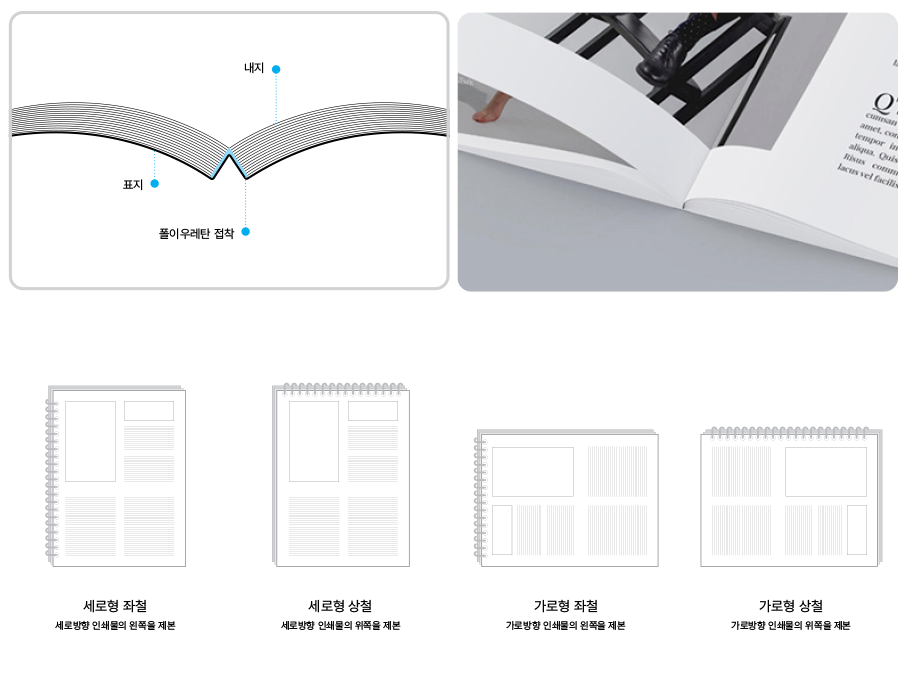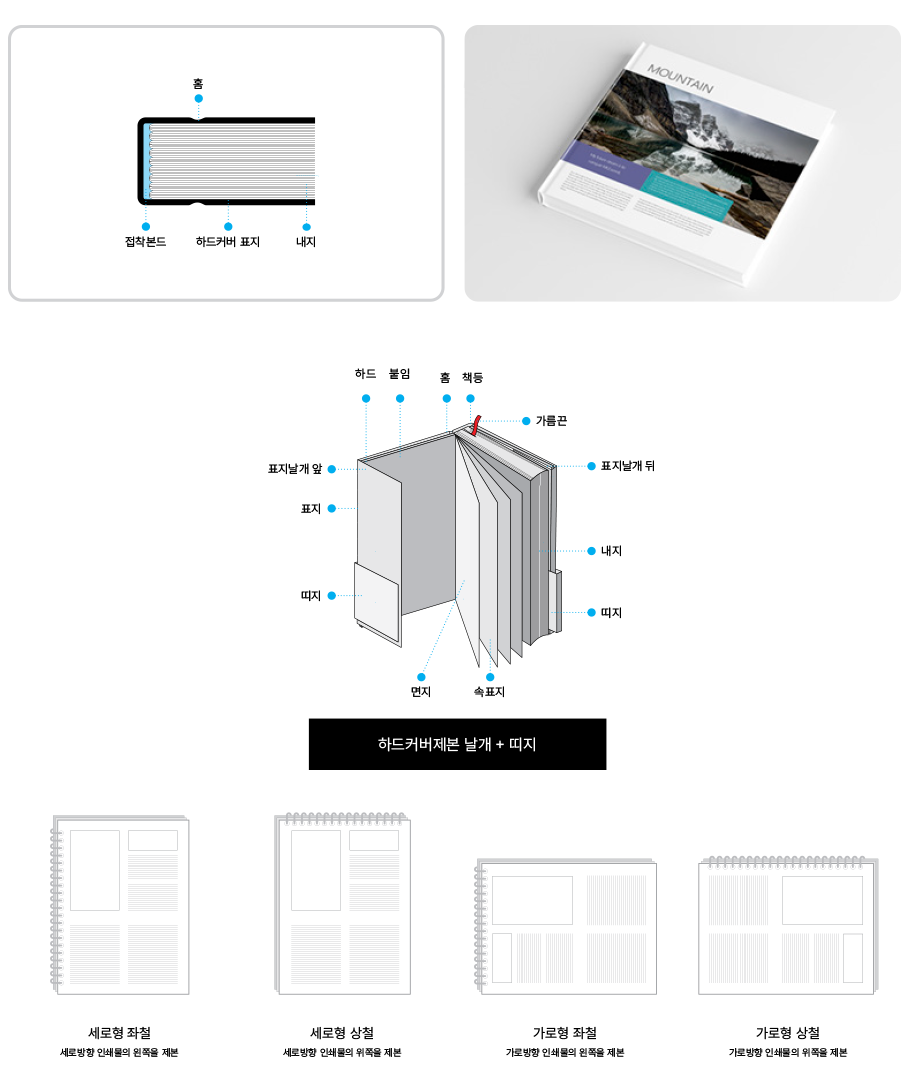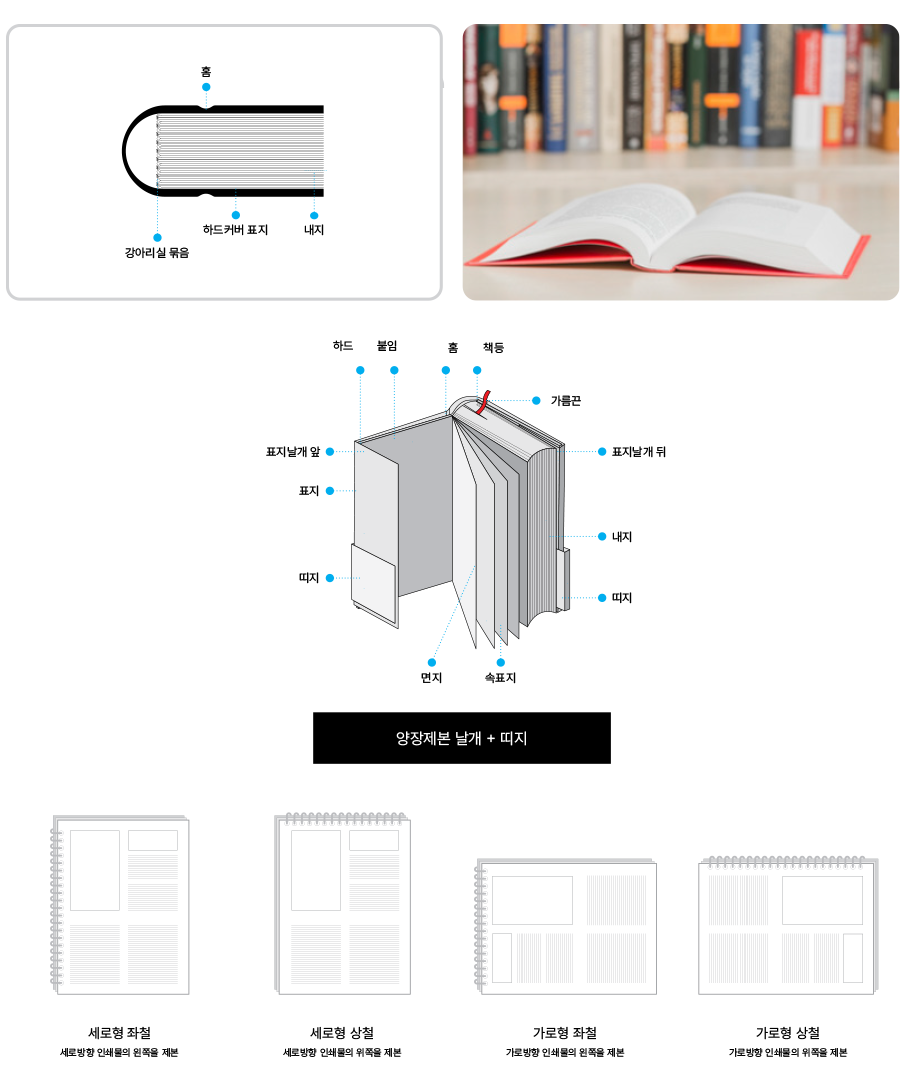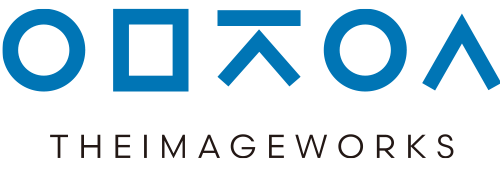제본방식 (Binding)
다양한 제본 기법으로 완성도를 높입니다
무선제본 (Perfect Binding)

무선제본은 가장 일반적인 단행본 제본 방식으로, 표지와 내지를 실 대신 접착제로만 접합해 단단히 고정합니다. 보통 내지를 모아 제본면을 기계로 ‘밀링(톱날 가공)’하여 표면을 거칠게 만든 뒤 접착제를 입히는 방법과, 제본면에 미세한 칼집(노칭)을 내어 그 틈으로 접착제가 스며들게 하는 방법의 두 가지로 나뉩니다. 이 공정 덕분에 접착제가 종이 결 사이로 깊이 침투해 내구성을 확보합니다.
무선제본은 반양장보다 펼침성이 좋은 편이지만, 지나치게 두꺼운 내지를 쓰면 제본면이 갈라질 수 있습니다. 제본 후에는 책등(세네카)이 형성되며, ‘무선철(無線綴)’ 또는 ‘퍼펙트 바인딩(Perfect Binding)’이라고도 부릅니다. 작업 목적에 따라 종이 두께와 접착제 종류(EVA, PUR 등)를 알맞게 선택하면 균열을 줄이고 펼침성을 더 안정적으로 확보할 수 있습니다.
Perfect binding is the most common method for single-volume books, where the cover and text block are bonded solely with adhesive rather than thread. In practice, the gathered pages are either spine-milled (creating a roughened surface with a saw-like cutter) before adhesive is applied, or micro-notched so that glue can penetrate the cuts; these are the two main approaches. Both processes allow the adhesive to seep into the paper fibers to ensure durability.
Compared with semi-hardcover binding, perfect binding generally opens flatter, but using overly thick stocks can cause the spine area to crack. A distinct spine (often called “Seneka” in Korean print shops) is formed, and the method is also known as “wireless binding” or simply “Perfect Binding.” Selecting suitable paper thickness and an appropriate adhesive (e.g., EVA or PUR) helps reduce cracking and maintain more reliable lay-flat performance.

PUR제본 (Poly Urethane Reactive)

무선제본은 가장 일반적인 단행본 제본 방식으로, 표지와 내지를 실 대신 접착제로만 접합해 단단히 고정합니다. 보통 내지를 모아 제본면을 기계로 ‘밀링(톱날 가공)’하여 표면을 거칠게 만든 뒤 접착제를 입히는 방법과, 제본면에 미세한 칼집(노칭)을 내어 그 틈으로 접착제가 스며들게 하는 방법의 두 가지로 나뉩니다. 이 공정 덕분에 접착제가 종이 결 사이로 깊이 침투해 내구성을 확보합니다.
얇은 본드 라인 덕분에 책등이 두껍게 부풀지 않고 견고함을 유지하며, 온도 변화와 장력에 대한 내성이 좋아 장기 내구성이 우수합니다. 다만 반응·경화 시간이 일반 EVA 접착제보다 길고 설비·관리 난이도가 높은 편이며, 구조상 무선제본과 동일하게 제본 후에는 책등(세네카)이 형성됩니다.
PUR binding is an advanced form of perfect binding that uses a polyurethane reactive adhesive (PUR) instead of conventional EVA glue. The PUR adhesive chemically cures by reacting with moisture in the paper and air, delivering strong adhesion and flexibility even with a very thin glue line—making it reliable for coated stocks and heavily inked pages.
Because the glue line is thin, the spine remains neat without excessive build-up while maintaining strength, and it offers excellent resistance to temperature changes and long-term stress. However, PUR typically requires a longer curing period and more specialized equipment and maintenance than EVA systems; structurally it is the same as perfect binding, so a visible spine is formed.

중철제본 (Saddle Stitching)

중철제본은 2장 이상의 인쇄물을 겹쳐 반으로 접은 뒤, 접힌 중앙선(등선)을 따라 스테이플(철심)로 고정하는 방식입니다. 페이지는 반드시 4의 배수(4, 8, 12, 16…)로 구성해야 하며, 책등(세네카)이 생기지 않기 때문에 표지와 내지의 작업 방식이 동일합니다. 얇고 가벼운 소책자, 팸플릿, 카탈로그 등에 적합하며 제작 공정이 단순합니다.
얇은 본드 라인 덕분에 책등이 두껍게 부풀지 않고 견고함을 유지하며, 온도 변화와장점은 비교적 비용이 저렴하고 펼침성이 좋아 평평하게 잘 펴진다는 점입니다. 다만 페이지 수가 많아지거나 내지가 두꺼울수록 ‘크립(가운데로 갈수록 안쪽 장이 바깥으로 밀려 나오는 현상)’ 때문에 재단 시 안쪽 페이지의 여백이 더 많이 잘릴 수 있어, 여백 설계와 크립 보정이 필요합니다. 또한 지나치게 두꺼운 용지나 많은 페이지 수에는 중철제본이 부적합합니다. 장력에 대한 내성이 좋아 장기 내구성이 우수합니다. 다만 반응·경화 시간이 일반 EVA 접착제보다 길고 설비·관리 난이도가 높은 편이며, 구조상 무선제본과 동일하게 제본 후에는 책등(세네카)이 형성됩니다.
Saddle-stitch binding stacks printed sheets, folds them in half, and staples along the folded spine. Page counts must be in multiples of four (4, 8, 12, 16, …). Because there is no square spine, the cover and text pages are prepared in essentially the same way. This method suits slim booklets, brochures, and catalogs, and the production process is straightforward.
Its advantages are low cost and excellent lay-flat opening. However, as page count increases or paper gets thicker, “creep” (inner pages protruding further before trim) can cause greater margin loss toward the center, so you should plan margins and apply creep compensation. For very thick stocks or high page counts, saddle-stitching becomes unsuitable.

하드커버 (Hardcover binding)

하드커버 제본은 두꺼운 표지 보드(케이스)와 표지 재질(천·가죽·종이 등)로 본문을 감싸는 방식으로, 외부 충격으로부터 내용을 튼튼하게 보호하고 고급스러운 인상을 줍니다. 포트폴리오, 포토북, 논문, 기록물처럼 존재감과 내구성이 중요한 인쇄물에 주로 쓰입니다. 다만 본문 두께가 너무 얇으면 케이스가 뜨거나 제본 구조가 불안정해 제작이 제한될 수 있습니다(페이지 수·용지 두께에 따라 최소 두께 요구).
얇은 본드 라인 덕분에 책등이 두껍게 부풀지 않고 견고함을 유지하며하드커버는 크게 각제본(평등·Flat Back)과 둥근제본(Rounded Back)으로 나뉩니다. 각제본은 책등이 평평해 단정하고 제목 인쇄·박 가공이 용이하며 현대적 느낌을 줍니다. 둥근제본은 책등을 곡면으로 성형해 클래식한 분위기와 장력 분산에 유리한 구조를 갖습니다. 내부 본문은 용도에 따라 실로 꿰매는 사철(Smyth sewing)이나 접착(EVA/PUR) 방식을 선택해 펼침성·내구성·예산을 균형 있게 맞춥니다., 온도 변화와 장력에 대한 내성이 좋아 장기 내구성이 우수합니다. 다만 반응·경화 시간이 일반 EVA 접착제보다 길고 설비·관리 난이도가 높은 편이며, 구조상 무선제본과 동일하게 제본 후에는 책등(세네카)이 형성됩니다.
PUR binding is an advanced form of perfect binding that uses a polyurethane reactive adhesive (PUR) instead of conventional EVA glue. The PUR adhesive chemically cures by reacting with moisture in the paper and air, delivering strong adhesion and flexibility even with a very thin glue linHardcover binding wraps the text block with rigid boards (the case) covered in cloth, leather, or printed paper, offering strong protection and a premium look. It’s commonly used for portfolios, photo books, theses, and archival works where durability and presence matter. However, if the book block is too thin, the case may not seat properly and the structure can be unstable, so a minimum thickness is often required (depending on page count and stock).e—making it reliable for coated stocks and heavily inked pages.
There are two main types: flat-back (square spine) and rounded-back spines. Flat-back cases look crisp and contemporary, and make spine titling and foil stamping straightforward. Rounded backs provide a classic appearance and help distribute stress along the spine. Inside, you can choose Smyth sewing (thread-sewn signatures) or adhesive methods (EVA/PUR) to balance lay-flat performance, longevity, and budget.

양장제본 (Case binding)

하드커버 제본은 두꺼운 표지 보드(케이스)와 표지 재질(천·가죽·종이 등)로 본문을 감싸는 방식으로, 외부 충격으로부터 내용을 튼튼하게 보호하고 고급스러운 인상을 줍니다. 포트폴리오, 포토북, 논문, 기록물처럼 존재감과 내구성이 중요한 인쇄물에 주로 쓰입니다. 다만 본문 두께가 너무 얇으면 케이스가 뜨거나 제본 구조가 불안정해 제작이 제한될 수 있습니다(페이지 수·용지 두께에 따라 최소 두께양장제본은 접지한 내지(시그니처)를 모아 등면에 미세한 칼집(노칭)·도포를 한 뒤, 실로 꿰매는 사철(Smyth sewing) 공정을 거쳐 책등을 평평하게(각배) 혹은 둥글게(둥근배) 성형합니다. 이후 거즈(크래시)와 보강재, 헤드밴드를 붙이고 면지로 본문과 케이스를 연결한 다음, 두꺼운 보드에 천·가죽·인쇄지를 입힌 하드커버(케이스)를 씌우는 케이싱(casing-in)으로 마무리합니다. 이 구조는 충격과 장력에 강하고 장기 보존에 유리합니다. 요구).
얇은 본드 라인 덕분에 책등이 두껍게 부풀지 않고 견고함을 유지하며하드커버는 크게 각제본(평등·Flat Back)과 둥근제본(Rounded Back)으로 나뉩니다. 각제본은 책등이 평평해 단정하고 제목 인쇄·박 가공이 용이하며 현대적 느낌을 줍니다. 둥근제본은 책등을 곡면으로 성형해 클래식한 분위기와 장력 분산에 유리한 구조를 갖습니다. 내부 본문은 용도에 따라 실로 꿰매는 사철(S완성물은 고급감과 내구성이 뛰어나 포트폴리오, 포토북, 논문, 기념집 등에 적합하며, 펼침성도 좋아 실사용에 안정적입니다(완전 180° 평탄 펼침은 전용 구조가 필요). 다만 수작업 비중과 공정 수가 많아 비용·제작 기간이 증가하고, 본문이 지나치게 얇으면 제작이 제한될 수 있습니다. 표지는 박·엠보싱·실크·포일 등 후가공 선택 폭이 넓어, 제목·로고 표현에 유리합니다.myth sewing)이나 접착(EVA/PUR) 방식을 선택해 펼침성·내구성·예산을 균형 있게 맞춥니다., 온도 변화와 장력에 대한 내성이 좋아 장기 내구성이 우수합니다. 다만 반응·경화 시간이 일반 EVA 접착제보다 길고 설비·관리 난이도가 높은 편이며, 구조상 무선제본과 동일하게 제본 후에는 책등(세네카)이 형성됩니다.
Case binding (hardcover) gathers folded signatures, applies light notching and adhesive at the spine, then thread-sews them via Smyth sewing before shaping the spine either flat (square back) or rounded. The block is reinforced with crash (mull), spine linings, and headbands; endpapers attach the text block to a rigid case made from boards wrapped in cloth, leather, or printed paper. This architecture offers high resistance to impact and long-term stress.
There are two main types: flat-back (square spine) and rounThe result is premium and durable—ideal for portfolios, photo books, theses, and commemorative volumes—with dependable opening performance (true lay-flat at 180° requires a dedicated construction). The trade-offs are higher cost and longer schedules due to more handwork, and very thin text blocks may not qualify. On the upside, the case accepts a wide range of finishings—foil, emboss/deboss, screen, etc.—which is excellent for spine and cover titling.ded-back spines. Flat-back cases look crisp and contemporary, and make spine titling and foil stamping straightforward. Rounded backs provide a classic appearance and help distribute stress along the spine. Inside, you can choose Smyth sewing (thread-sewn signatures) or adhesive methods (EVA/PUR) to balance lay-flat performance, longevity, and budget.

© 이미지웍스의 모든 이미지는 저작권의 보호를 받습니다. 외부 사용 시 사전 허가가 필요하며, 공유하실 때는 반드시 'ImageWorks'를 출처로 표기해 주세요.
© All images by ImageWorks are protected by copyright. External use requires prior permission; when sharing, please credit “ImageWorks” as the source.

